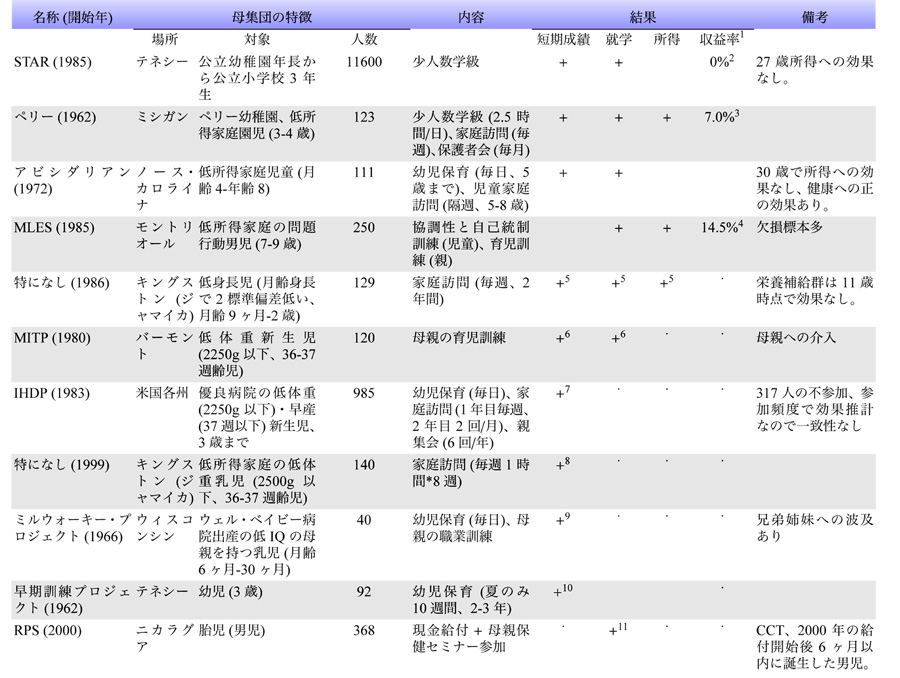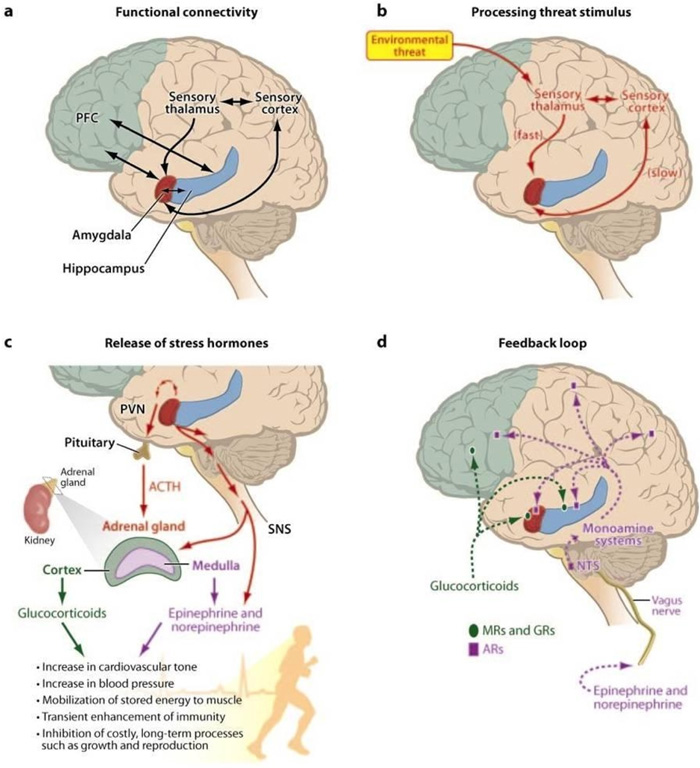IDEスクエア
海外研究員レポート
早期児童教育介入と効果発現メカニズム
PDF版ダウンロードページ:http://hdl.handle.net/2344/00049855
2014年9月
貧困解消と早期児童発達
19世紀米国で活躍した教育改革者ホーレス・マンによれば、教育は人間の資質を平等にする「偉大な装置」である。マンの主張が正しければ、教育の機会が平等になれば、貧困も解消し、不平等もなくなるはずである。その際には、富裕層よりも貧困層の所得がより高く伸び、子の所得と親の所得の結びつきが弱まるために世代間所得の相関は低くなるはずである。
「万人のための教育」(Education for All)が唱えられ、就学率が飛躍的に伸びて教育機会の平等化が進んだ途上国では、所得分配は平等化しているだろうか。途上国100カ国以上の家計調査を用いた研究によれば、途上国全体で2000 年まで国内所得は不平等化しており、2000年以降も不平等度はほぼ横ばいである(Ravallion, 2014)。先進国では所得分配が不平等なほど世代間所得の相関は高いことが知られているため(Autor, 2014, Figure 5A)、不平等が解消されない途上国の世代間所得の相関も低下していないと推論できる1。
こうした傾向は、マンの唱えたメカニズムが十分に機能していないことを示唆している。この機能不全は教育促進政策の効果の低さとしても現れている。先進国を対象とした研究によれば、成人を対象にした就業訓練、10代および小学生を対象にした職業訓練、学業補助、生活指導など、効果はゼロではないにしても、費用対効果が低い(Cunha et al.,2006)。途上国成人対象の識字訓練も効果が低いという報告がある(Carron, 1990; Ortega and Rodríguez, 2008)。途上国貧困層対象の経営訓練も効果が低い(Karlan and Valdivia,2011)2。これは、一定年齢に到達すると、貧困層を豊かにするほどの人的資本蓄積効果を上げるには、多額の予算を要することを示している。
対照的に、健常な発達が危ぶまれる家庭環境の乳幼児を対象に実施された早期児童発達(early childhood development, ECD)プログラムの費用対効果は高い。表1は、正確に効果が分かる実験デザインを採用したECDプログラムのリストである3。ECDプログラムは古くは1960年代から開始されているが、実験的な介入を用いる研究デザインの複雑さから、STARを除けば少人数である4。また、実施場所も先進国が多く、途上国での経験はあまり知られていない。
1. 所得増を便益、プロジェクト費用を費用とする私的内部収益率。
2. 27歳時点での所得増ゼロ(Chetty et al., 2011)。
3. Heckman et al. (2010)の最も少なめに見積もった推計値。健康への効果はCampbell et al. (2014)の報告。
4. 筆者による計算。Algan et al. (2012)が推計した時給増$1.23に1週間20 時間労働*40年間を掛けて便益を合計し、
プロジェクト費用$8736を費用として使った。欠損値が多いために計算された収益率は不正確で信頼性が低い。
5. 2歳での知能テストの結果(Grantham-McGregor et al., 1991, 11歳での知能テストも同様の結果)と11歳でのドロップ
アウトの結果。ただし、小標本でstimulation実施群と統御群の差の検定はないが、より小さな差(正常身長群と
統御群の差)がp = :045と報告されている(Walker et al., 2005)。所得は20年後の105人の追跡結果(Gertler et al., 2014)。
6. 9歳での知能テストの結果と9歳での進級状況(Achenbach et al., 1993)。
7. 3歳での知能テストの結果(Ramey et al., 1992)。
8. 月齢7歳でのおもちゃ取得テストの結果(Gardner et al., 2003)。
9. 6歳での知能テストの結果(Garber, 1988, p.90)。
10. 5歳での知能テストの結果、女子のみが有意、男子は非有意。就学は17歳時点、所得は21歳時点で両性とも
非有意(Anderson, 2008)。
11. 介入が胎児時点、結果は7歳時の知能テストの平均効果(Barham et al., 2013)。
12. “.”は計測されていない指標、空欄は効果は計測されたが統計的に有意ではなかった指標。
こうした制約があるにせよ、過去のECDからは学ぶべき点が多い5。とくに、表1でも見て取れるように、認知能力(cognitive skills)を短期的に伸ばし、学業実績も伸ばすことは、多くのプログラムに共通しており、政策立案者や研究者の強い関心を集めている。成人時の所得への効果が確認できないプログラムがあるにも関わらず学業実績を伸ばすことから、ECDは認知能力には大きな影響を与えず、むしろ自己規律や協調性などの非認知能力(noncognitive skills)への効果が高いと考えられている6。非認知能力は社会で豊かに暮らすうえで必須であり、労働市場での評価も高めるため、認知能力と並んで重要な資質である。マンが唱えた平等化の装置が存在するのではないか、という期待が募る所以である。
多くの政策担当者や研究者が期待をかけるECDであるが、効果発現のメカニズムを示す社会科学研究は少ない。Cunha et al. (2010)は、観察データながらも、経済モデルを援用しながら親による育児が認知能力と非認知能力を高める過程を推計している。そこでは認知能力は早期に開発しなければ取り戻しのつかない不可逆性があること、非認知能力はより後期でも開発可能であることが強調されている。しかし、親が特定の行動を取ると子どもの知的能力が変化する、という行動分析に留まっており、「なぜ」を解明できていない。
認知科学の分野では、30年以上も前からECD効果発現の具体的なメカニズムを説明できる基礎研究が積み上げられている。脳科学、神経医学、発達心理学、遺伝学では、上述のような認知能力開発の不可逆性はとくに主張されておらず、貧困に起因するストレスが子どもの認知能力と非認知能力に与える負の効果が詳しく検証されている。
アロステイシス
以下で考えるストレスとは、栄養不足、知的刺激不足、運動不足、世話不足、育児放棄、不衛生、騒音、暴力など、子どもの発達における環境不備を指す。こうしたストレスが脳に与える影響を考える上で基本となる概念がアロステイシス(allostasis)7である。これは環境変化を予測しながら体が徐々に変化順応する課程を指す(Sterling and Eyer, 1988)。ストレスが強かったり長引くと、ストレス反応を繰り返すだけでなく、反応がストレス解消後にも長引いたり、特定の反応が不十分になって新たなストレス反応を引き起こすなど、体に負荷がかかる。この負荷をアロスタティック負荷(allostatic load) という。アロスタティック負荷は、心肺、代謝、免疫、神経分泌などの経路を通じて体に変化を与え、幼少期から負荷が加わると脳の組成や機能を変化させる。アロスタティック負荷は各種の生体マーカーで計測できる(Juster et al., 2010)。
ストレスと脳への効果
ストレス反応とアロステイシスを統御するのは脳である。ストレスが与えられると、HPA軸(視床下部-下垂体-副腎系)を中心に反応が起こる。図1の(c)のように、視床下部が検知し、下垂体と副腎系からCRF(副腎皮質刺激ホルモン放出ホルモン)やACTH(副腎皮質刺激ホルモン)の増加を通じてアドレナリンやコルティゾルを放出し、体を環境変化に順応させる。ブドウ糖や体に蓄積された脂肪の活用、動悸を高めた血流増加、毛細血管を収縮させた血圧上昇、免疫機能の活発化、呼吸を急にするなど、短期的な危険や不安に対する機敏な動作を可能にする準備を整える。一方、過度なストレス反応は消耗するため、(d)のように、海馬(hippocampus)や扁桃体(amygdala)は、受容体で糖質コルチコイド(GC)ホルモンやモノアミンを探知し、HPA軸への指令を通じてストレス反応を制御する。前頭前皮質(prefrontal cortex)も自律神経、扁桃体などに指令を送ってストレス反応を統御する。
この脳の反応は、危険やストレスを感じたときに緊張を高め、体を危険から守るのに役立つ。しかし、ストレスが長期化すると、アロスタティック負荷によって健康が損なわれてしまう。長期ストレスによって受容体の量や機能が変化し、受容体を多く持つ海馬や扁桃体が管轄する学習、記憶、動作の脳内メカニズムに影響を及ぼす(Sapolsky et al.,1986)。長期ストレスは扁桃体を通じて不安や恐怖への過剰な反応を引き起こしやすい[Conrad et al., 1999;Erickson et al., 2009;McEwen and Gianaros, 2011, 5.7; Shonkoff et al.,2012, e236]。恒常的なストレス下にあると成人期に海馬が縮小し、動作や知覚を担う灰白質が減り(Gianaros et al., 2007)、記憶や知的能力に影響を与えることが示唆されている(Sheline, 2003; McEwen and Gianaros, 2010)。児童期の体罰を経験した成人は前頭前皮質の灰白質が少ないことが知られている(Tomoda et al., 2009)。また、早産は乳児の大脳皮質における神経回路が減ることが示されている(Pandit et al., 2013)。
長期のストレスはストレス反応の統御機能も損なうと考えられている。幼少期にストレスを経験した成人は、HPA軸によるコルティゾルの発生が弱まりストレスへの適切対応が困難になる(Gunnar and Donzella, 2002; Carpenter et al., 2009)。海馬縮小により、その機能低下がストレス反応統御機能を低めることも示唆されている(McEwen and Gianaros, 2011)。長期にわたるコルティゾルの増加は、前頭前皮質のストレス反応統御作用、認知能力、実行機能なども損なう(Wellman, 2001)。
動物実験からも貴重な知見が得られている8。ストレス下の脳がストレス反応を統御するときには糖質コルチコイド(GC)を放出するが、母体へのストレスを通じて胎内のGCを増やされたサルは、成体時の海馬が通常よりも小さい(Uno et al., 1989)。ラット実験では、胎内でGCが増えるとストレス反応過敏になり(Weinstock, 2001)、サルの実験では母サルの世話を少なくさせると、ストレスを感じた子ザルの脳でCRF が増え、ストレス反応過敏になることが知られている(Coplan et al., 1996)。ラット実験では、世話減少によるストレス過敏が子ラットをランダムに取り替えても確認されるので、遺伝とは無関係に発生することが分かる(Francis et al., 1999)。以上は発達への負の刺激であるが、正の刺激が知的能力を高める可能性も示されている9。ラットのすみかを放水仕掛けのある迷路に取り替えると、海馬のニューロンが増える(Kempermann et al., 1997)。ラットの育成環境の知的刺激を増やすと、樹状突起やシナプス数が増え、迷路などの空間学習を促進する(van Praag et al., 2000)。
社会経済地位(SES) と脳発達
低所得の方がストレスの影響を強く受けている子どもが多いため(Evans et al., 2007; Evans and Kim, 2012; McEwen and Gianaros, 2010)、認知科学では社会経済地位(SES)の低さと脳発達の関係が注目されている。ストレスが長期化すれば、アロスタティック負荷が高まり、脳の発達の妨げになる。既存研究では、ストレスを受ける期間や貧困期間が長いほど交感神経やHPA 軸などが影響を受けて作業記憶を衰退させ(Evans and Schamberg, 2009)、唾液内のコルティゾルが増え(Lupien et al., 2000)、慢性炎症(Danese et al., 2008; Miller and Chen, 2010)を引き起こすことが示されている。途上国でも、ストリート・チルドレンの方がアロスタティック負荷が高いなど、貧困と脳発達の関係が指摘されている(Worthman and Panter-Brick, 2008)。
貧困由来のストレスによって健全な脳発達が妨げられると、学習機会が平等に与えられたとしても、長期的ストレスを受けずに育った富裕層の子どもと比して、貧困層の子どもは学習成果を上げにくくなる。今までは教育機会平等の保証(Education for All)によって貧困が解消されると期待されていたが、健常に脳を発達させる機会なしにはその期待も裏切られかねない。
介入の時期と正当性
脳の発達機会平等を保証するためには、脳発達のプロセスを知らねばならない。脳の発達は部位によって一様ではない。異なる時期にさまざまな栄養素を取り込み、ストレスを適正に統御することで、健全な発達を遂げる(Thomas and Knowland, 2009)。脳発達を促す上で最も効果のある時期、つまり、最も可塑性(plasticity)がある時期は早期だけという臨界期(critical period)仮説を支持する証拠(Cunha et al., 2010)よりも、より後期にも影響を受けるという敏感期(sensitive period)仮説を支持する証拠が多い(Wachs et al., 2014, p.2)10。しかし、現時点では具体的な介入指針を作れるほど発達過程が十分に解明されていないため、過度なストレスを与えず、知的刺激と適度な運動のある育児を保護者が実施し、栄養不足にならないように脳発達に必要な栄養素を常に潤沢に摂取させることが望ましい。
ECDと脳の発達が重要な問題であるとはいえ、敢えて政策介入するためには、放置しておくと社会に損失を与えることが示されねばならない。放置することの社会的損失は大きく(Knudsen et al., 2006; Shonkoff and Bales, 2011)、ECDは私的な問題ではなく、社会的な問題であることが2つの点から指摘できる。
一つには医療費と犯罪の費用である。例えば、幼少期にストレスを与えられると、問題行動を起こしやすい遺伝子発現(gene expression)となりやすいほか、ストレス回避行動として喫煙や過食などの不健康な嗜好、アルコール中毒、過剰な賭博などの行動に結びつきやすい。ECD介入によって、肥満、アルコール中毒を減らすことができれば、疾病予防費用の軽減になる。こうした健康上危険のある行動を抑制できれば、その他の慢性疾患を減らして、巨額の医療費節約も可能になる(Shonkoff et al., 2012, e237)。医療費用は公的保険を通じて社会が負担しているため、疾病を減らせば社会的損失を減らすことができる。さらに、問題行動から犯罪に発展する経路を遮断することができれば、犯罪被害を減らすことで追加的な社会的便益も得られる。
二つ目は、脳という資源未利用の機会費用である。低所得家計は子どもの脳の発達を十分に促進する環境を用意できず、子どもの認知能力、社会性、学習能力などを育むことができない場合がある。知識や手持ち資金が不足して親が良好な環境を用意できないのであれば、市場の失敗によって脳発達が阻まれていると解釈できる。このため、社会的便益が仮にゼロの場合でも私的収益率が高ければ、脳発達への投資が非効率なまでに過小になり、公的な介入が正当化できる。
途上国対象の学際的研究の必要性
ECDプログラムの効果のほとんどは先進国の事例を検討している。後期教育介入の費用対効果の低さを示した研究も、ほとんどが先進国の事例である。このため、途上国の教育介入として、ECDの優先度を後期教育よりも高く設定すべき直接の証拠はない。途上国では通常の教育成果が低いため(Kremer et al., 2013)、先進国では効果を上げなかった政策も高い効果を持つかもしれない11, 12。
その一方で、教育が成果を出すには脳の発達が前提となる。このため、ECDを通じて貧困層児童の脳の発達を支援することは、乳幼児の能力を高めるだけでなく、Cunha et al.(2010)が議論したように後期教育介入の効果をさらに高めることも期待できる(Knudsen et al., 2006)。認知科学の成果は、貧困家庭に生まれた子どもは富裕家庭の子どもよりも脳の健常な発達を遂げてないために、平等な機会を与えられても、同等の成果を実現できない可能性がより高いことを示している。すべての社会階層が成長の成果を共有するために、ECDプログラムの重要性は高い。
教育促進政策分析は、ECDの費用対効果が高いこと、とくに非認知能力を高める可能性を明らかにした。しかし、少数の行動分析を別として、ECDになぜそのような効果があるのか、メカニズムを明示することなくブラックボックスとして扱っている。認知科学は脳の発達について膨大な研究を積み上げ、長期的ストレスが脳発達を阻むメカニズムを示してきた。しかし、ストレスの原因となる貧困と親の行動ついては分析が不十分であった。とくに、貧困が親による人的資本投資をいかに制約するか考慮していない。脳内メカニズムは詳細に分析されているが、家族内や社会における知能発達過程の考慮が不十分なために、貧困によるストレスの影響を遮断するための具体的な政策提言に結びつきにくい。この点、教育開発を扱う社会科学の諸分野には、家族や社会における人的資本投資に関する研究蓄積が豊富である。脳発達のメカニズムの解明が進むにつれ、具体的にどのような知的刺激や環境整備が必要かが明らかになるであろう。こうした行動を実践するのは子どもの保護者である。教育開発を扱う社会科学の諸分野は、保護者が適切な行動をとるように導く手段を明らかにすることで、認知科学との学際的研究を可能にし、マンの唱えた「偉大な装置」が機能するようにできるかもしれない。
《参考文献》
- Achenbach, Thomas M., Catherine T. Howell, Melanie F. Aoki, and Virginia A. Rauh, "Nine-Year Outcome of the Vermont Intervention Program for Low Birth Weight Infants," Pediatrics, 1993, 91 (1), 45–55.
- Algan, Yann, Elizabeth Beasley, Richard E Tremblay, and Franck Vittaro, "The Long- Term Impact of Social Skills Training at School Entry: A randomized controlled trial.," 2012.
- Anderson, Michael L ., "Multiple Inference and Gender Differences in the Effects of Early Intervention: A Reevaluation of the Abecedarian, Perry Preschool, and Early Training Projects," Journal of the American Statistical Association, 2008, 103 (484), 1481–1495.
- Autor, David H., "Skills, education, and the rise of earnings inequality among the 'other 99 percent'," Science, 2014, 344 (6186), 843–851.
- Barham, Tania, Karen Macours, and John A. Maluccio, "Boys’ Cognitive Skill Formation and Physical Growth: Long-Term Experimental Evidence on Critical Ages for Early Childhood Interventions," The American Economic Review, 2013, 103 (3), 467–471.
- Black, Sandra E and Paul J Devereux, "Recent developments in intergenerational mobility," in "Handbook of labor economics," Vol. 4, Elsevier, 2011, pp. 1487–1541.
- Bloom, Nicholas, Benn Eifert, Aprajit Mahajan, David McKenzie, and John Roberts, "Does Management Matter? Evidence from India," The Quarterly Journal of Economics, 2013, 128 (1), 1–51.
- Campbell, Frances, Gabriella Conti, James J. Heckman, Seong Hyeok Moon, Rodrigo Pinto, Elizabeth Pungello, and Yi Pan, "Early Childhood Investments Substantially Boost Adult Health," Science, 2014, 343 (6178), 1478–1485.
- Carpenter, Linda L., Audrey R. Tyrka, Nicole S. Ross, Lamya Khoury, George M. Anderson, and Lawrence H. Price, "Effect of Childhood Emotional Abuse and Age on Cortisol Responsivity in Adulthood," Biological Psychiatry, 2009, 66 (1), 69–75. Stress, Traumatization, and Anxiety Disorders.
- Carron, Gabriel, "The functioning and effects of the Kenya literacy program," African studies Review, 1990, 33 (03), 97–120.
- Chetty, Raj, John N. Friedman, Nathaniel Hilger, Emmanuel Saez, Diane Whitmore Schanzenbach, and Danny Yagan, "How Does Your Kindergarten Classroom Affect Your Earnings? Evidence from Project STAR," The Quarterly Journal of Economics, 2011, 126 (4), 1593–1660.
- Conrad, Cheryl D, Ana Mar´ıa Magari˜ nos, Joseph E LeDoux, and Bruce S McEwen, "Repeated restraint stress facilitates fear conditioning independently of causing hippocampal CA3 dendritic atrophy.," Behavioral neuroscience, 1999, 113 (5), 902.
- Coplan, J D, M W Andrews, L A Rosenblum, M J Owens, S Friedman, J M Gorman, and C B Nemeroff, " Persistent elevations of cerebrospinal fluid concentrations of corticotropin-releasing factor in adult nonhuman primates exposed to early-life stressors: implications for the pathophysiology of mood and anxiety disorders," Proceedings of the National Academy of Sciences, 1996, 93 (4), 1619–1623.
- Cunha, Flavio, James J. Heckman, and Susanne M. Schennach, "Estimating the Technology of Cognitive and Noncognitive Skill Formation," Econometrica, 2010, 78 (3), 883–931.
- Cunha, James J Heckman, Lance Lochner, and Dimitriy V Masterov, "Interpreting the evidence on life cycle skill formation," Handbook of the Economics of Education, 2006, 1, 697–812.
- Currie, Janet and Duncan Thomas, "Early test scores, school quality and SES: Longrun effects on wage and employment outcomes," Research in Labor Economics, 2001, 20, 103–132.
- Danese, Andrea, Terrie E Moffitt, CarmineMPariante, Antony Ambler, Richie Poulton, and Avshalom Caspi, "Elevated inflammation levels in depressed adults with a history of childhood maltreatment," Archives of general psychiatry, 2008, 65 (4), 409–415.
- Erickson, Kirk I., Ruchika S. Prakash, Michelle W. Voss, Laura Chaddock, Liang Hu, Katherine S. Morris, Siobhan M. White, Thomas R.W´ojcicki, Edward McAuley, and Arthur F. Kramer, "Aerobic fitness is associated with hippocampal volume in elderly humans," Hippocampus, 2009, 19 (10), 1030–1039.
- Evans, GaryW. and Michelle A. Schamberg, "Childhood poverty, chronic stress, and adult working memory," Proceedings of the National Academy of Sciences, 2009, 106 (16), 6545–6549.
- Evans, GaryW. and Pilyoung Kim, "Childhood Poverty and Young Adults’Allostatic Load: The Mediating Role of Childhood Cumulative Risk Exposure," Psychological Science, 2012, 23 (9), 979–983.
- Evans, Gary W, Pilyoung Kim, Albert H Ting, Harris B Tesher, and Dana Shannis, "Cumulative risk, maternal responsiveness, and allostatic load among young adolescents.," Developmental psychology, 2007, 43 (2), 341.
- Francis, Darlene, Josie Diorio, Dong Liu, and Michael J. Meaney, "Nongenomic Transmission Across Generations of Maternal Behavior and Stress Responses in the Rat," Science, 1999, 286 (5442), 1155–1158.
- Galobardes, B, J W Lynch, and G Davey Smith, "Is the association between childhood socioeconomic circumstances and cause-specific mortality established? Update of a systematic review," Journal of Epidemiology and Community Health, 2008, 62 (5), 387–390.
- Garber, Howard L, The Milwaukee Project: Preventing Mental Retardation in Children At Risk., ERIC, 1988.
- Gardner, Julie Meeks, Susan P Walker, Christine A Powell, and Sally Grantham- McGregor, "A randomized controlled trial of a home-visiting intervention on cognition and behavior in term low birth weight infants," The Journal of Pediatrics, 2003, 143 (5), 634 – 639.
- Gertler, Paul, James Heckman, Rodrigo Pinto, Arianna Zanolini, Christel Vermeersch, Susan Walker, Susan M. Chang, and Sally Grantham-McGregor, "Labor market returns to an early childhood stimulation intervention in Jamaica," Science, 2014, 344 (6187), 998–1001.
- Gianaros, Peter J., J. Richard Jennings, Lei K. Sheu, Phil J. Greer, Lewis H. Kuller, and Karen A. Matthews, "Prospective reports of chronic life stress predict decreased grey matter volume in the hippocampus," NeuroImage, 2007, 35 (2), 795 – 803.
- Grantham-McGregor, S.M, C.A Powell, S.P Walker, and J.H Himes, "Nutritional supplementation, psychosocial stimulation, and mental development of stunted children: the Jamaican Study," The Lancet, 1991, 338 (8758), 1 – 5. Originally published as Volume 2, Issue 8758.
- Gunnar, Megan R. and Bonny Donzella, "Social regulation of the cortisol levels in early human development," Psychoneuroendocrinology, 2002, 27 (1-2), 199 – 220.
- Heckman, James J., Seong Hyeok Moon, Rodrigo Pinto, Peter A. Savelyev, and Adam Yavitz, "The rate of return to the HighScope Perry Preschool Program," Journal of Public Economics, 2010, 94 (1-2), 114 – 128.
- Juster, Robert-Paul, Bruce S. McEwen, and Sonia J. Lupien, "Allostatic load biomarkers of chronic stress and impact on health and cognition," Neuroscience and Biobehavioral Reviews, 2010, 35 (1), 2 – 16. Psychophysiological Biomarkers of Health.
- Karlan, Dean and Martin Valdivia, "Teaching entrepreneurship: Impact of business training on microfinance clients and institutions," Review of Economics and Statistics, 2011, 93 (2), 510–527.
- Kempermann, Gerd, H Georg Kuhn, and Fred H Gage, "More hippocampal neurons in adult mice living in an enriched environment," Nature, 1997, 386, 493–495.
- Knudsen, Eric I., James J. Heckman, Judy L. Cameron, and Jack P. Shonkoff, "Economic, neurobiological, and behavioral perspectives on building America’s future workforce," Proceedings of the National Academy of Sciences, 2006, 103 (27), 10155–10162.
- Kremer, Michael, Conner Brannen, and Rachel Glennerster, "The Challenge of Education and Learning in the Developing World," Science, 2013, 340 (6130), 297–300.
- Lupien, Sonia J, Suzanne King, Michael J Meaney, and Bruce S McEwen, "Child’s stress hormone levels correlate with mother’s socioeconomic status and depressive state," Biological Psychiatry, 2000, 48 (10), 976 – 980.
- McEwen, Bruce S. and Peter J. Gianaros, "Central role of the brain in stress and adaptation: Links to socioeconomic status, health, and disease," Annals of the New York Academy of Sciences, 2010, 1186 (1), 190–222.
- McEwen, Bruce S. and Peter J. Gianaros, "Stress- and Allostasis-Induced Brain Plasticity," Annual Review of Medicine, 2011, 62 (1), 431–445. PMID: 20707675.
- Miller, Gregory E. and Edith Chen, "Harsh Family Climate in Early Life Presages the Emergence of a Proinflammatory Phenotype in Adolescence," Psychological Science, 2010.
- National Scientific Council on the Developing Child, Excessive stress disrupts the architecture of the developing brain number 3. In ‘Working Paper.’, Center on the Developing Child, Harvard University, 2005.
- Ortega, Daniel and Francisco Rodr´ıguez, "Freed from illiteracy? a closer look at Venezuela’s Misi´on Robins´on literacy campaign," Economic Development and Cultural Change, 2008, 57 (1), 1–30.
- Pandit, A.S., E. Robinson, P. Aljabar, G. Ball, I.S. Gousias, Z. Wang, J.V. Hajnal, D. Rueckert, S.J. Counsell, G. Montana, and A.D. Edwards, "Whole-Brain Mapping of Structural Connectivity in Infants Reveals Altered Connection Strength Associated with Growth and Preterm Birth," Cerebral Cortex, 2013.
- Ramey, Craig T., Donna M. Bryant, Barbara H. Wasik, Joseph J. Sparling, Kaye H. Fendt, and Lisa M. La Vange, "Infant Health and Development Program for Low Birth Weight, Premature Infants: Program Elements, Family Participation, and Child Intelligence," Pediatrics, 1992, 89 (3), 454–465.
- Ravallion, Martin, "Income inequality in the developing world," Science, 2014, 344 (6186), 851–855.
- Rodrigues, Sarina M., Joseph E. LeDoux, and Robert M. Sapolsky, "The Influence of Stress Hormones on Fear Circuitry," Annual Review of Neuroscience, 2009, 32 (1), 289– 313. PMID: 19400714.
- Sapolsky, Robert M, Lewis C Krey, and Bruce S McEwen, "The Neuroendocrinology of Stress and Aging: The Glucocorticoid Cascade Hypothesis," Endocrine Reviews, 1986, 7 (3), 284–301. PMID: 3527687.
- Sheline, Yvette I, "Neuroimaging studies of mood disorder effects on the brain," Biological Psychiatry, 2003, 54 (3), 338 – 352.
- Shonkoff, Jack P. and Susan Nall Bales, "Science Does Not Speak for Itself: Translating Child Development Research for the Public and Its Policymakers," Child Development,
- Shonkoff, Andrew S. Garner, the Committee on Psychosocial Aspects of Child and Family Health, Committee on Early Childhood, Adoption, and Dependent Care, Section on Developmental and Behavioral Pediatrics, Benjamin S. Siegel, Mary I. Dobbins, Marian F. Earls, Andrew S. Garner, Laura McGuinn, John Pascoe, and David L. Wood, "The Lifelong Effects of Early Childhood Adversity and Toxic Stress," Pediatrics, 2012, 129 (1), e232–e246.
- Solon, Gary, "Cross-Country Differences in Intergenerational Earnings Mobility," The Journal of Economic Perspectives, 2002, 16 (3), 59–66.
- Sterling, Peter and Joseph Eyer, "Allostasis: a new paradigm to explain arousal pathology.," in Shirley Fisher and James Reason, eds., Handbook of life stress, cognition and health, John Wiley & Sons, 1988, pp. 629–649.
- Thomas, Michael SC and V Knowland, "Sensitive periods in brain development– implications for education policy," European Psychiatric Review, 2009, 2 (1), 17–20.
- Tomoda, Akemi, Hanako Suzuki, Keren Rabi, Yi-Shin Sheu, Ann Polcari, and Martin H. Teicher, "Reduced prefrontal cortical gray matter volume in young adults exposed to harsh corporal punishment," NeuroImage, 2009, 47, Supplement 2 (0), T66 – T71. International Brain Mapping; Intraoperative Surgical Planning Society (IBMISPS).
- Uno, H, R Tarara, JG Else, MA Suleman, and RM Sapolsky, "Hippocampal damage associated with prolonged and fatal stress in primates," The Journal of Neuroscience, 1989, 9 (5), 1705–1711.
- van Praag, Henriette, Gerd Kempermann, and Fred H Gage, "Neural consequences of enviromental enrichment," Nature Reviews Neuroscience, 2000, 1 (3), 191–198.
- Wachs, Theodore D., Michael Georgieff, Sarah Cusick, and Bruce S. McEwen, "Issues in the timing of integrated early interventions: contributions from nutrition, neuroscience, and psychological research," Annals of the New York Academy of Sciences, 2014, 1308 (1), 89–106.
- Walker, Susan P, Susan M Chang, Christine A Powell, and Sally M Grantham- McGregor, "Effects of early childhood psychosocial stimulation and nutritional supplementation on cognition and education in growth-stunted Jamaican children: prospective cohort study," The Lancet, 2005, 366 (9499), 1804 – 1807.
- Weinstock,M, "Alterations induced by gestational stress in brain morphology and behaviour of the offspring," Progress in Neurobiology, 2001, 65 (5), 427 – 451.
- Wellman, Cara L ., "Dendritic reorganization in pyramidal neurons in medial prefrontal cortex after chronic corticosterone administration," Journal of Neurobiology, 2001, 49 (3), 245–253.
- Worthman, Carol M and Catherine Panter-Brick, "Homeless street children in Nepal: Use of allostatic load to assess the burden of childhood adversity," Development and psychopathology, 2008, 20 (01), 233–255.
脚注
- 先進各国では世代間所得の相関は0.2-0.4 と比較的強く(Solon, 2002; Black and Devereux, 2011)、親の所得と子どもの健康状態にも強い正の相関がある(Galobardes et al., 2008)。英国でも親の所得が低いほど高校数学の成績が低く、33 歳時の雇用確率や所得も低い(Currie and Thomas, 2001)。米国でも親の所得と成績には強い正の相関がある(Cunha et al., 2006)。
- 途上国でも既存の企業対象であれば、経営指導の効果は高い(Bloom et al., 2013)。すでに設立されている企業の経営者は、人的資本を一定程度まで蓄積しているためかもしれない。
- 保健だけのプログラムは除外している。
- このため、内的整合性はあるが外的整合性に乏しいといわれる。
- STAR、ペリー、アビシダリアンの各プログラムは先駆的、かつ、成人時まで追跡調査をしているために、幾度も分析された有名プログラムである。
- ただし、複数指標を検定することのバイアスを考慮した研究では、成人期女子の認知能力にも弱い影響を与えることが示されている(Anderson, 2008)。
- ギリシア語による命名で「変化することで安定を保つ」という意味。対義語に体の安定状態を示すホメオステイシスhomeostasis があり、ギリシア語では「同じ水準を保つ」という意味。
- 動物の知能は人間よりも低いために、知的能力に対する影響を人間と同じように解釈できない。脳の組成も人間は早期に完成するのに対して、ラットなどは成体になるまで発達を続ける。こうした差異はあるにせよ、刺激投与と解剖を通じてメカニズムがより詳細に解明できる長所がある。
- National Scientific Council on the Developing Child (2005) はストレスを良好(positive)、負担(tolerable)、毒性(toxic) の3 段階に分類している。軽度であればストレスには脳発達を促す機能がある。
- ただし、ECD が長期的な社会性や自己規律などの非認知能力の発達を促すという結果からは、神経回路の可塑期は非認知能力の可塑期よりも早いことを示唆している。
- 後期教育介入の効果とは、通常の教育と比較して介入がどれだけ結果指標を高めたかを示している。このため、先進国のように通常の教育成果が十分に高ければ、介入が成果を伸ばす余地は少ない。
- この疑問を筆者に投げかけたのは、MV財団およびハイデラバード大学政治学部のシャンタ・シンハ教授である。記して感謝する。




